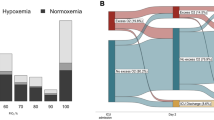Abstract
Purpose
In Sepsis-3, the quick Sequential Organ Failure Assessment (qSOFA) score was developed as criteria to use for recognizing patients who may have poor outcomes. This study was performed to evaluate the predictive performance of the qSOFA score as a screening tool for sepsis, mortality, and intensive care unit (ICU) admission in patients with febrile neutropenia (FN). We also tried to compare its performance with that of the systemic inflammatory response syndrome (SIRS) criteria and Multinational Association of Supportive Care in Cancer (MASCC) score for FN.
Methods
We used a prospectively collected adult FN data registry. The qSOFA and SIRS scores were calculated retrospectively using the preexisting data. The primary outcome was the development of sepsis. The secondary outcomes were ICU admission and 28-day mortality.
Results
Of the 615 patients, 100 developed sepsis, 20 died, and 38 were admitted to ICUs. In multivariate analysis, qSOFA was an independent factor predicting sepsis and ICU admission. However, compared to the MASCC score, the area under the receiver operating curve of qSOFA was lower. qSOFA showed a low sensitivity (0.14, 0.2, and 0.23) but high specificity (0.98, 0.97, and 0.97) in predicting sepsis, 28-day mortality, and ICU admission.
Conclusions
Performance of the qSOFA score was inferior to that of the MASCC score. The preexisting risk stratification tool is more useful for predicting outcomes in patients with FN.

Similar content being viewed by others
References
Bone RC, Balk RA, Cerra FB et al (1992) Definitions for sepsis and organ failure and guidelines for the use of innovative therapies in sepsis. The ACCP/SCCM Consensus Conference Committee. American College of Chest Physicians/Society of Critical Care Medicine. Chest 101(6):1644–1655
Shankar-Hari M, Phillips GS, Levy ML et al (2016) Developing a new definition and assessing new clinical criteria for septic shock: for the third international consensus definitions for sepsis and septic shock (sepsis-3). JAMA 315(8):775–787. doi:10.1001/jama.2016.0289
Singer M, Deutschman CS, Seymour CW et al (2016) The third international consensus definitions for sepsis and septic shock (sepsis-3). JAMA 315(8):801–810. doi:10.1001/jama.2016.0287
Seymour CW, Liu VX, Iwashyna TJ et al (2016) Assessment of clinical criteria for sepsis: for the third international consensus definitions for sepsis and septic shock (sepsis-3). JAMA 315(8):762–774. doi:10.1001/jama.2016.0288
Deutschman CS (2016) Imprecise medicine: the limitations of sepsis-3. Crit Care Med 44(5):857–858. doi:10.1097/CCM.0000000000001834
Marshall JC (2016) Sepsis-3: what is the meaning of a definition? Crit Care Med 44(8):1459–1460. doi:10.1097/CCM.0000000000001983
Vincent JL, Martin GS, Levy MM (2016) qSOFA does not replace SIRS in the definition of sepsis. Crit Care 20(1):210. doi:10.1186/s13054-016-1389-z
Simpson SQ (2016) New sepsis criteria: a change we should not make. Chest 149(5):1117–1118. doi:10.1016/j.chest.2016.02.653
Wang JY, Chen YX, Guo SB, Mei X, Yang P (2016) Predictive performance of quick Sepsis-related Organ Failure Assessment for mortality and ICU admission in patients with infection at the ED. Am J Emerg Med 34(9):1788–1793. doi:10.1016/j.ajem.2016.06.015
Chen YX, Wang JY, Guo SB (2016) Use of CRB-65 and quick Sepsis-related Organ Failure Assessment to predict site of care and mortality in pneumonia patients in the emergency department: a retrospective study. Crit Care 20(1):167. doi:10.1186/s13054-016-1351-0
Churpek MM, Snyder A, Han X et al (2016) qSOFA, SIRS, and early warning scores for detecting clinical deterioration in infected patients outside the ICU. Am J Respir Crit Care Med. doi:10.1164/rccm.201604-0854OC
Klastersky J, Paesmans M (2013) The Multinational Association for Supportive Care in Cancer (MASCC) risk index score: 10 years of use for identifying low-risk febrile neutropenic cancer patients. Support Care Cancer 21(5):1487–1495. doi:10.1007/s00520-013-1758-y
DeLong ER, DeLong DM, Clarke-Pearson DL (1988) Comparing the areas under two or more correlated receiver operating characteristic curves: a nonparametric approach. Biometrics 44(3):837–845
Lewis MA, Hendrickson AW, Moynihan TJ (2011) Oncologic emergencies: pathophysiology, presentation, diagnosis, and treatment. CA Cancer J Clin 61(5):287–314. doi:10.3322/caac.20124
Jaimes FA, De La Rosa GD, Valencia ML et al (2013) A latent class approach for sepsis diagnosis supports use of procalcitonin in the emergency room for diagnosis of severe sepsis. BMC Anesthesiol 13(1):23. doi:10.1186/1471-2253-13-23
Author information
Authors and Affiliations
Corresponding author
Ethics declarations
Conflict of interest
The authors declared that they have no conflicts of interest. We have full control of all primary data and agree to allow the journal to review the data if requested.
Electronic supplementary material
ESM 1
(DOCX 14 kb)
Rights and permissions
About this article
Cite this article
Kim, M., Ahn, S., Kim, W.Y. et al. Predictive performance of the quick Sequential Organ Failure Assessment score as a screening tool for sepsis, mortality, and intensive care unit admission in patients with febrile neutropenia. Support Care Cancer 25, 1557–1562 (2017). https://doi.org/10.1007/s00520-016-3567-6
Received:
Accepted:
Published:
Issue Date:
DOI: https://doi.org/10.1007/s00520-016-3567-6




